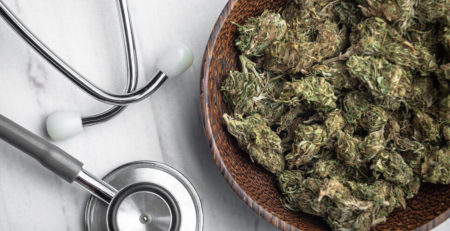Cannabis and Chronic Pain – A Comprehensive Guide to Relief.
The chronic pain experienced by millions of Canadians is a complex condition that is often difficult to manage. While there are many conventional treatments, such as pharmaceutical drugs and surgery, cannabis and cannabinoid therapy may offer more natural and non-pharmaceutical relief. Cannabidiol (CBD) and Tetrahydrocannabinol (THC), two primary components of medical marijuana, interact with the body’s endocannabinoid system to provide a range of analgesic and therapeutic effects. These cannabinoids, together with other therapeutic benefits of medical marijuana, offer a potential alternative to traditional pain medications for various chronic pain conditions.
At Hydro Green, we understand the complexity of chronic pain and the importance of finding relief.
Overview of Cannabis and Its Uses
Cannabis has become increasingly popular for its therapeutic benefits, with Cannabidiol (CBD) and Tetrahydrocannabinol (THC) as two of its most studied chemical components. Cannabis has numerous uses, ranging from medical marijuana to pain management, and its cannabinoid receptors and endocannabinoid system are thought to be beneficial in treating neuropathic pain and providing analgesic effects.
Types of Cannabis
Transitioning away from the chemical components of cannabis, let’s take a look at the different types of cannabis available. Cannabis can be divided into two main categories: Cannabidiol (CBD) and Tetrahydrocannabinol (THC). While both have therapeutic benefits, they serve vastly different purposes.
Medical marijuana is typically high in THC, and is used for treating a variety of conditions, such as pain management. THC activates the body’s cannabinoid receptors, which are part of the endocannabinoid system, and has been found to be an effective treatment for neuropathic pain.
Chemical Components of Cannabis
Transitioning from an overview of cannabis and its uses, it’s time to dive into the chemical components of cannabis. Cannabidiol (CBD) and Tetrahydrocannabinol (THC) are the two main cannabinoids that have been researched, though there are many others. Medical marijuana is often used for pain management, as these cannabinoids interact with the body’s cannabinoid receptors, which are part of the endocannabinoid system. Cannabinoids are known to help with neuropathic pain, by providing analgesic effects. Different cannabis strains are available, providing alternative forms of medicine and pain relief properties.
Benefits of Cannabis
With the increasing legalization of cannabis, more and more research has provided evidence to the medicinal benefits of this plant. From pain management to palliative care, cannabis has shown to be an effective tool in providing relief to various chronic conditions. Cannabinoid therapy has been found to be a natural form of pain relief by targeting cannabinoid receptors and activating the endocannabinoid system. Studies have found that Cannabidiol (CBD) and Tetrahydrocannabinol (THC) both have analgesic effects, and can be used to treat neuropathic pain.
Benefits of Cannabis for Chronic Pain
The benefits of cannabis for chronic pain are numerous and wide-ranging. From Cannabidiol (CBD) to Tetrahydrocannabinol (THC), medical marijuana has been found to be an effective pain management tool. Cannabis works on the body’s cannabinoid receptors, which are part of the endocannabinoid system. Studies have found that marijuana can be helpful in relieving neuropathic pain, and has analgesic effects, as well as anti-inflammatory and neuroprotective properties.
Effects on Neuropathic and Inflammatory Pain
The effects of cannabis on neuropathic and inflammatory pain are becoming increasingly understood, thanks to the cannabis research that has been conducted in recent years. Studies have revealed that cannabis compounds like Cannabidiol (CBD) and Tetrahydrocannabinol (THC) have a plethora of medicinal benefits, particularly in the area of pain management. These compounds work by interacting with the body’s cannabinoid receptors, which are part of the endocannabinoid system. This system helps regulate certain bodily functions, including pain perception.
Benefits of CBD
The use of Cannabidiol (CBD) and other cannabis components like Tetrahydrocannabinol (THC) has become increasingly popular for the management of chronic pain. Medical marijuana has been shown to have analgesic effects on neuropathic and inflammatory pain, as well as a variety of other cannabinoid receptors and the endocannabinoid system. Studies have indicated that CBD is particularly effective in pain relief and has anti-inflammatory and neuroprotective properties. The cannabis strains and alternative medicine used for pain relief have become more accepted as cannabis legalization has increased.
Dosage and Administration of Cannabis for Chronic Pain
Transitioning from an overview of cannabis and its uses to the benefits of cannabis for chronic pain, the focus now shifts to dosage and administration of cannabis for chronic pain. Dosage and administration of cannabis for chronic pain is an important issue which requires careful monitoring, due to the potential for side effects and the variability of individual responses to cannabis. It is important to note that Cannabidiol (CBD) and Tetrahydrocannabinol (THC) are the two primary compounds found in cannabis that have been studied for their potential analgesic effects in the management of chronic pain. The endocannabinoid system, which is composed of cannabinoid receptors and endogenous cannabinoids, is key to the pain-relieving effects of cannabis.
How to Use Cannabis for Pain Relief
Pain relief through cannabis is becoming increasingly popular as Cannabis legalization spreads and more patient testimonials are shared. It is important to understand the therapeutic benefits of cannabis in order to find the right strain and consumption type for maximum pain relief.
The endocannabinoid system in the body reacts to Cannabidiol (CBD) and Tetrahydrocannabinol (THC), two of the most common cannabinoids found in medical marijuana.
Finding the Right Strain
Finding the right strain of cannabis is essential for pain relief. With cannabis legalization becoming increasingly common, the selection of available strains is greater than ever. Different cannabis strains have different levels of Tetrahydrocannabinol (THC) and Cannabidiol (CBD), and each has different pain relief properties. Knowing which strain will work best for you can be overwhelming. Fortunately, Hydro Green’s knowledgeable staff is here to help guide you to the right strain.
It is important to consider your level of chronic pain, the type of pain management you need and your preferred method of consumption.
Choosing the Right Form of Consumption
In order to properly use cannabis for pain relief, it is important to understand the effects of various cannabis strains and forms of consumption. Choosing the right form of consumption is essential for achieving the desired results. Different forms of cannabis have varying levels of Tetrahydrocannabinol (THC) and Cannabidiol (CBD), and different forms of consumption can produce different effects.
Smoking is the most common form of cannabis consumption, but it is not always the best for pain relief. Other options include edibles, topical creams, tinctures, and vaporizers. Inhaled cannabis can have effects lasting up to 4 hours, while consuming cannabis orally can produce effects lasting up to 8 hours.
Delivery Methods for Cannabis and Pain Relief
The next step in understanding how to use cannabis for pain relief is exploring the various delivery methods available. Hydro Green is a leader in providing safe access to cannabis products for pain relief, with a wide variety of options such as graded cannabis flowers, concentrates, edibles, and vape pens. Each delivery method has its own unique benefits, and should be tailored to the specific needs of the patient, as well as their individual preferences.
For example, cannabis-infused edibles provide a different experience than vaping or smoking, and are often preferred by those seeking a more discreet method.
Potential Drug Interactions
Potential Drug Interactions can be serious and even life-threatening, so it is important to be aware of them.Prescription Drugs are powerful and often have strong side effects, so it is important to consult with a doctor before taking any. Over the Counter Drugs can also interact with other medications, so it is important to read the label carefully and only take what is recommended. Symptoms of Drug Interactions may include nausea, vomiting, headaches, or dizziness.
In addition to traditional drugs, there is a growing field of alternative medicines which can also interact with other drugs.
Prescription Drugs
Transitioning from the previous section on how to use cannabis for pain relief, it’s essential to understand the potential drug interactions that may occur when using medical marijuana. Prescription drugs, as well as over the counter drugs, can interact with cannabis, leading to symptoms that can be potentially serious. When taking prescription drugs, it’s important to discuss with your doctor the use of cannabidiol (CBD), tetrahydrocannabinol (THC), and medical marijuana for pain management and cannabinoid receptors, and the effects on the endocannabinoid system.
Over the Counter Drugs
Using cannabis to manage pain can be an effective alternative to many over the counter drugs, but it is important to be aware of the potential for drug interactions. In particular, cannabis and over the counter drugs can interact in ways that can be harmful to the user. It is important to be aware of the potential for these interactions, and to consult with a doctor or healthcare professional when using cannabis and over the counter drugs together.
The risks associated with combining over the counter drugs and cannabis can differ depending on the specific drug and the quantity. Some of the potential risks include increased heart rate, increased risk of addiction, and an increased risk of side effects.
Symptoms of Drug Interactions
As we discussed in the previous section, cannabis has many potential benefits for pain relief, including cannabinoid receptors, endocannabinoid system, neuropathic pain, analgesic effects, and pain relief properties. However, it is important to understand the potential drug interactions that can occur when using cannabis, or any other medication, in conjunction with other drugs. Symptoms of drug interactions can range from mild to severe and can be life-threatening in some cases. Therefore, it is important to be aware of the potential risks and to be aware of the signs and symptoms of a drug interaction.
Ways to Enhance the Effects of Cannabis
Combining Cannabis with other natural remedies can greatly improve its effectiveness and enhance its effects. For instance, CBD and THC can be used together to provide pain relief, while medical marijuana can be used with alternative medicine to provide additional therapeutic benefits. Additionally, cannabinoid receptors can be activated through the endocannabinoid system to provide neuropathic pain relief with analgesic effects.
Combining Cannabis with Other Natural Remedies
Making the switch from traditional pharmaceuticals to natural remedies has become more popular as people seek relief from chronic pain and other medical issues. Combining cannabis with other natural remedies can be a beneficial way to boost the effects of cannabis while minimizing potential risks.
Cannabis has medical properties, including Cannabidiol (CBD) and Tetrahydrocannabinol (THC) that interact with the body’s endocannabinoid system and cannabinoid receptors, which can help relieve pain, inflammation, and other ailments. Combining cannabis with other natural remedies may further enhance the effects of cannabis and provide additional relief from chronic pain and other medical conditions.
Alternative medicinal plants may provide complementary therapeutic benefits that work in conjunction with cannabis.
Improving the Efficacy of Cannabis
Making the most out of your cannabis experience is key to unlocking the full benefits of medical marijuana. Improving the efficacy of cannabis can be done in a few different ways, such as combining it with other natural remedies and enhancing its effects with topical applications. Cannabidiol (CBD) is one of the most popular natural remedies that can be combined with Tetrahydrocannabinol (THC) to improve the efficacy of medical marijuana. When used together, these two compounds can increase the pain management and analgesic effects of cannabis, while also offering anti-inflammatory and neuroprotective benefits.
Enhancing Cannabis Effects with Topicals
This section looks at ways to enhance the effects of cannabis, specifically through the use of topicals. By applying topical cannabis products directly to the skin, cannabinoids such as Cannabidiol (CBD) and Tetrahydrocannabinol (THC) can be absorbed without entering the bloodstream. This makes topicals a great choice for those looking to explore the potential medical benefits of cannabis without the psychotropic effects. In particular, topicals have been used to help manage a variety of medical conditions, including pain, inflammation, and skin conditions such as psoriasis. Cannabinoid receptors in the skin are activated when the topical is applied, and this can help with pain management and provide analgesic effects.
Legal Considerations
Legal Considerations in regards to State Laws on Cannabis, Medical Cannabis Cards, Criminal Offences and Penalties are important to understand. Different states have different laws and regulations, so it is important to be aware of the laws within your state. Cannabidiol (CBD) and Tetrahydrocannabinol (THC) are two of the primary active ingredients found in cannabis. States may allow medical marijuana for certain medical conditions, such as pain management, and require a medical cannabis card for use.
State Laws on Cannabis
A key component to consider when discussing the use of cannabis is state laws on the matter, as these can vary across the country. Cannabis legalization has been a much-debated issue, with many states adopting medical marijuana laws in recent years. For instance, the use of Cannabidiol (CBD) and Tetrahydrocannabinol (THC) for pain management and other medical conditions has been studied extensively and is gaining traction in many states. In addition, research on the potential therapeutic benefits of cannabis has been growing, with many patient testimonials providing evidence that cannabis can be used to treat a variety of ailments.
Medical Cannabis Cards
Taking the next step in cannabis use is understanding the legal considerations associated with it. One of the most important to be aware of is the ability to access medical marijuana through Cannabis cards. To obtain a card, patients must be evaluated by a physician who has registered with the state health department and diagnosed with one of the qualifying medical conditions. Once approved, the patient will be able to purchase Cannabidiol (CBD) and Tetrahydrocannabinol (THC) products from a licensed dispensary.
Cannabis cards have many benefits, as they offer a legitimate way for patients to access medical marijuana.
Criminal Offences and Penalties
It’s important to remember when consuming cannabis that there are legal considerations to be aware of. In particular, it is essential to be aware of the criminal offences and penalties that may arise from the use of cannabis products. Cannabis possession and cultivation are still considered illegal in many states and possession or sale of cannabis products can lead to fines, prison time, or both. In some states, cannabis possession is a felony and can lead to a sentence of more than a year in prison. It is also important to note that possession or sale of cannabis products without a medical cannabis card may carry even harsher penalties in some states. Therefore, it is essential to be aware of the laws and regulations in your local area before purchasing or consuming cannabis products.
Safety Tips for Using Cannabis
It’s important to start slow and low when using cannabis. Avoid driving or operating machinery while under the influence of cannabis or any other substance. Using cannabis carries risks, so it is important to understand them before using.
The two main cannabinoids in cannabis are Cannabidiol (CBD) and Tetrahydrocannabinol (THC), which have different effects. Medical marijuana is often used for pain management, as it interacts with cannabinoid receptors in the endocannabinoid system, which helps to manage neuropathic pain.
Start Slow and Low
Without a doubt, safety is the primary consideration when it comes to using cannabis. To ensure the best experience possible, it is important to start slow and low. This means beginning with a very small dose of cannabis and gradually increasing the amount until the desired effect is achieved. This is especially true for those who may not be familiar with the effects of various cannabis products.
Cannabis contains two primary active compounds, tetrahydrocannabinol (THC) and cannabidiol (CBD). Depending on the strain, the ratio of these two compounds can vary greatly. It is important to be mindful of the THC and CBD levels when using cannabis to ensure the desired effects are achieved.
Avoid Driving or Operating Machinery
Having explored the legal considerations of using cannabis, it is important to also consider the safety of using cannabis. One of the most important safety tips to consider when using cannabis is to avoid driving or operating machinery. This is due to the fact that cannabis consumption can impair an individual’s cognitive and motor skills, which can be dangerous when operating machinery or driving a vehicle. Even if the cannabis used has high amounts of Cannabidiol (CBD), it can still impair an individual’s ability to drive or operate machinery safely. Additionally, when using cannabis, it is important to understand the ratio of Tetrahydrocannabinol (THC) to CBD, as higher levels of THC can cause more impairment.
Understanding the Risks of Cannabis Use
Moving on from the legal considerations of cannabis use, it is important to consider the safety tips for using cannabis. Understanding the risks of cannabis use is essential to ensure that you are using cannabis safely and responsibly. Cannabis, like many other substances, has both potential benefits and drawbacks. Cannabis contains chemical compounds such as cannabidiol (CBD) and tetrahydrocannabinol (THC), which interact with our body’s own cannabinoid receptors and endocannabinoid system to produce a variety of effects. Cannabis is often used for medical purposes, such as pain management, and its analgesic effects, anti-inflammatory and neuroprotective properties are well-documented.
Conclusion
Cannabis has become increasingly popular as a natural form of relief for chronic pain conditions. Its therapeutic benefits have been backed by evidence-based medicine, patient testimonials, and research into its medicinal properties. It has been found to provide relief from chronic pain through its anti-inflammatory, neuroprotective, and analgesic effects.
By combining cannabis with other forms of alternative medicine, such as herbal remedies and lifestyle modifications, patients can achieve holistic pain relief and improved quality of life. Cannabis can be an effective part of a patient-centered care plan, empowering them to take control of their health and reducing their reliance on pharmaceutical treatments. Patients should discuss their options with their healthcare provider to determine the best course of action for their individual needs.
@meta: Discover how cannabis can be used to provide relief from chronic pain. Learn about dosage, types of cannabis, and alternative treatments in this comprehensive guide.








